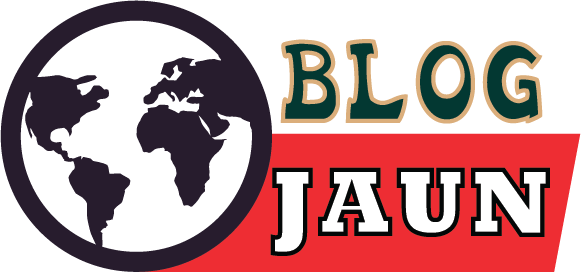Having grown up in southernmost England in the Eighties and Nineties, my awareness of Northern Ireland started and ended with grim news reports about bombs and bloodshed. About the actual place, its history, culture and geography, I knew almost nothing. Plenty of friends and relatives went on holiday to Scotland or Wales, but no one crossed the Irish Sea. This unconscious blockade remained in place until my early-30s when I met my partner, Anton, whose roots lay in rural North Antrim. The learning curve was steep, but a key turning point came when, sitting outside a cafe in Derry as the streets filled with besuited marching men thumping bellymounted drums, Anton thrust into my hands a copy of A Place Apart by the late, great travel writer Dervla Murphy.
An account of many weeks spent cycling around Northern Ireland, A Place Apart is a travel book like no other. Most extraordinary is the time of its setting: Murphy cycled to Northern Ireland from her home in the south at the height of the Troubles, summer 1976, and didn’t flinch at sparking up conversations with strangers in some of the diciest locations. These interactions she found addictive, the place beguiling. By the end of her travels, she was urging her friends to visit the north, assuring them that they would “find the people as welcoming [as in the south], the scenery as good, the roads better, and the weather no worse.” To my friends from southern England, I would go further: Northern Ireland beats our region on all these points – except perhaps the weather. And now I’m back here seeking to prove my case.
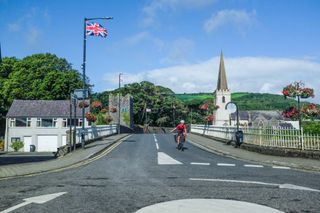
Between flag and steeple: the North remains a place apart
(Image credit: Anton Thompson-McCormick)
Our journey begins beneath the ramparts of Carrickfergus castle, built by the Anglo-Norman knight John de Courcy in 1177, on the northern shore of Belfast Lough. It was here that Protestant King William III first set foot in Ireland in 1690 to finish the job having deposed Catholic King James II – a keystone event for northern loyalists. Before we’ve even turned a pedal, a jovial middle-aged man on a folding e-bike stops for a chat about the adventures he and his mates have enjoyed lately. It’s the kind of freewheeling, unrushed encounter you rarely have in southern England. But we must be getting on, for the sky is beginning to bruise.
All the presidents’ glen
Sure enough, within a few minutes it’s spitting with rain and we briefly take shelter inside the cottage where the parents of the seventh US president Andrew Jackson had lived before emigrating to the Carolinas in 1765. The cottage is now a museum that perhaps not surprisingly emphasises Jackson’s political nous while downplaying his penchant for ethnic cleansing. You have to wonder if bullishness is in the blood around here when you learn that Jackson was the first of at least 15 US presidents with Scots-Irish heritage – from Jackson right through to Barack Obama. Stepping back outside, the drizzle has set in, washing out the views, so we resolve to get closer to the scenery with a cliffside clamber.
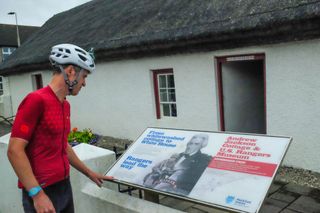
(Image credit: Anton Thompson-McCormick)
The Gobbins is a cliff-face along the eastern coast of the Islandmagee peninsula about 10 miles north of Carrickfergus. It’s raining steadily by the time we arrive, so we dive into the visitor centre for a coffee and traybake (this region’s sweet treats are unapologetically indulgent). Before we twig why, we’re being kitted out in sturdy boots and hard hats, before being introduced to our tour guide Jim and loaded into a minibus. The trek begins a short drive away, on a craggy path that was chiselled from the cliff-face at the turn of the 20th century. Jim is a superb guide who in short, animated bursts explains how the white-knuckle path, with its two miles of steps, tunnels and bridges, was the labour of love of railway engineer Berkeley Deane Wise. As we scramble along this most improbable tourist trail – as bonkers as it is beautiful – I can’t help wondering at Wise’s fervent quest to tame nature and open to visitors a place otherwise only accessible to gulls, kittiwakes and puffins.
This must be the place
Back in the minibus, I get chatting to the driver, Paula, who tells me she has lived here for 40 years. “I’m from the Isle of Wight originally but I came here on my bike in 1984. I thought it was better here,” she says matter-of-factly, “so I stayed.” Visiting here as a lone female cyclist in those troubled times – the same year as the Brighton bombing – and falling in love with the place seems uncannily similar to Dervla Murphy’s experience. Too many questions flood my mind, so I mumble something vague about how she must have seen a lot of changes here. She grins at me with a sympathetic expression that says: look around you, what’s not to love?
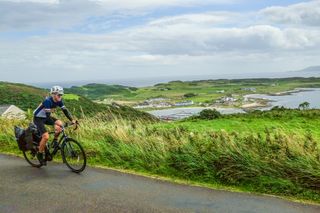
Getting away from it all on Rathlin Island
(Image credit: Anton Thompson-McCormick)
We’re getting used to the rain by now and it’s not cold so we do a loop of the peninsula before picking up the Antrim coast road. Like the Gobbins path on a giant scale, the coast road is a feat of engineering that seems to defy logic. Rather than connecting the towns of villages of the glens with inland roads, civil engineer William Bald proposed to carve out a route along the base of the cliffs for nearly 40 miles, from Larne to Ballycastle. Between 1832 and 1842, he did just that by blasting away tens of thousands of cubic metres of rock, clearing a spectacular route along the shoreline. Just north of Larne, we pedal past a roadside memorial paying homage to the “men of the Glynnes” who chipped away until the coast was cleared. As the road twists and turns, the hue of the rock shifts from light limestone to red sandstone to black basalt – the latter forming a stunning natural 5km-to-go gantry as we pass beneath The Black Arch for our first-day finale to the Ballygally hotel.
The latest race content, interviews, features, reviews and expert buying guides, direct to your inbox!
Hammered by Torr head
The next morning, the rain has cleared and the view from the hotel is a treat: sun glinting off the sea, the curve of the bay framed by craggy headland. Double helpings of potato bread are called for at the breakfast buffet, as today is our biggest day of riding. We’re continuing north along the coast road, up and over Torr Head to Ballycastle – and word at reception is that steep gradients lie ahead. It starts off benignly enough, with a glorious unbroken view of the sea to our right, lush green hills to our left and the sun gently warming our backs. Delighting in the scenery and filling our lungs with air tangy with the scent of dulse – edible seaweed, a local delicacy – I lose all sense of time. Before I know it, we’re passing beneath the Red Arch that marks the end of Bald’s rock-hewn road.
So far, the only sectarian symbols I’ve noticed have been a few Union flags flapping in the breeze, clustered in the unionist-majority areas we’ve passed through, and the odd evangelical banner reminding us that hell awaits sinners. But as we park the bikes for lunch in Cushendall, I notice a plaque commemorating the hunger striker Bobby Sands, a giveaway that this village leans nationalist. There are still sectarian tensions in Northern Ireland, of course, but there has been no sustained resurgence in violence since the 1998 Good Friday Agreement. The year Murphy toured around here, 1976, was one of the worst, with nearly 300 deaths, yet even then she refused to let the darkness overwhelm. Riding into Cushendall on a clear day, looking out across the “sparkling and glinting of the blue-green sea” and beyond to Scotland, she noted: “During such interludes the North’s tragedy seems merely a nightmare and its beauty the only reality.”
Once thoroughly refuelled, we roll out of Cushendall and turn sharp left on a deliberate detour inland. We’re taking on Glenaan, one of the nine famous glens, U-shaped valleys formed by glaciers during the last Ice Age some 17,000 years ago. It’s three miles to the top at a gradient of 5%, which doesn’t sound too bad, except the howling wind is now directly against us – and it’s starting to rain. Contrary to the fine forecast, by the time we’re halfway up, it’s lashing down so hard we can barely see our front wheels, let alone the surrounding vistas. “It’s bloody August!” I yell above the roar, but the only sheep within earshot stares at me pitilessly. As we reach the end of the valley and turn onto the descent down Glendun, the rain stops and the sun reappears. The scene is transformed as if a rapture is taking hold; the drenched surfaces glitter, vapour swirls and rainbows form above us.
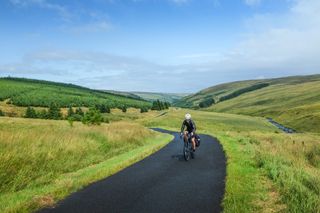
Dodging downpours goes with the territory in the glens
(Image credit: Anton Thompson-McCormick)
At the foot of Glendun is the village of Cushendun, and we stop for a coffee to warm up. Our lodgings tonight are the Salthouse hotel in Ballycastle, only about 15 miles away, but between here and there is the stretch we’ve been warned about, up and over Torr Head. The next seven miles surpass their reputation. It’s one of those roads that tricks you again and again into thinking you’ve reached the top. The first ramp is rewarded with a stunning view across to the Mull of Kintyre, though I’m far too short of breath to blast out the chorus of the Wings anthem. When Murphy “sweated up” this road in 1976, she looked out to sea and recalled the myth of the Children of Lir, changed into swans by their father’s jealous second wife and left bobbing around on the Moyle waves for centuries waiting for the first chimes of a Christian bell. When finally it rang out, they became children again and promptly drowned. “Maybe Christianity never brought much luck in this part of the world,” Murphy wryly noted.
I’m longing to be mythically transfigured, ideally into the form of Tadej Pogačar, as the vicious gradients keep coming like an endless roller coaster. The pièce de résistance is the half-mile climb at a near-14% average gradient up to Torr Head itself. Ballasted with panniers and sapped from the earlier drenching, it’s everything I can do just to keep going – hats off to the KOM holder, EF Education’s Archie Ryan, who blasted up here at 8.6mph. Finally on a direct course west, Knocklayde mountain, the last lonesome hill for miles around, beckons us towards our destination, Ballycastle. Foolishly, I assume it’s all downhill from here, only to discover our hotel is halfway up Knocklayde, yet another grinding 7.5% climb. My hands are shaking from carb depletion by the time I totter into the entrance, and rarely has a pint (or three) of Guinness been more intensely appreciated.
Rest day cast away
The next day is mercifully a rest day, more or less, allowing us to catch the passenger ferry across to Rathlin Island, 11km off the Ballycastle coast. Though the island is only four miles long, with a population of just 150, our lazy lunch leaves us only time for a very quick pedal around. The whole place feels lost in time and beyond the reach of the petty worries of mainland life; I’m sorry we have to leave so soon, but our return ferry is waiting. Once back on dry land, we head west and after just a few miles zig-zag down off the coast road for iced coffee and cake at Ballintoy beach. The car park is rammed, and the attraction soon becomes clear. It’s a fantasy shoreline – literally, they filmed a Game of Thrones scene here – sandy beach meets rock-strewn sea, outcrops glimmering like disco balls in the descending sun. Surfers high on endorphins swagger back to their cars, wetsuits peeled to the waist as though the temperature were living up to their California dreaming. But the reality is, I’m getting cold – and a warming dram beckons.
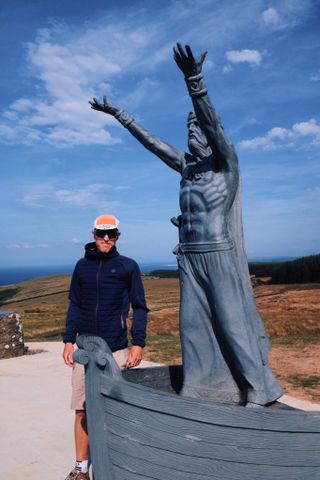
Christian vandals beware: this Celtic diety’s no pushover
(Image credit: Anton Thompson-McCormick)
After time-trialling the remaining 10 miles to ward off shivers, we step into an otherworldly aura of a different kind. The dark, cosy Bushmills Inn dates back to the early-1600s, making it as old as the nearby whisky distillery, reputed to be the world’s oldest – and inevitably rife with ghosts. The complimentary miniature in our room is a welcome aperitif and sure antidote against any lingering bad spirits. After a sound night’s sleep undisturbed by the Grey Lady, our fi nal day’s riding begins with a mere 10-minute ride down the Giant’s Causeway. Naturally I’d seen pictures of the bizarre interlocking columns – apparently formed from lava flows 50 million years ago – but that hasn’t prepared me for the eff ect up close. How am I meant to swallow that this perfectly arranged expanse of hexagons, nature’s grandest patio, was not crafted by intelligent design, be it that of God or a giant named Finn MacCool? It’s not quite my conversion moment, but down here on the hexagons, nothing seems impossible.
With a plane to catch later, there are just 30 miles left to cover. This final stretch of the tour takes us westward along the north coast, through the seaside towns of Portrush and Portstewart, and over the River Bann to our journey’s end, Gortmore viewpoint. And what a view it is: standing alongside a 10ft-tall bearded figure flashing impressive abs and stretching out his arms as if casting a spell, we gaze out over a vast expanse of land and sea extending from Donegal, the northernmost county of the Republic, to the Scottish islands of Islay and Jura. Googling the statue, I discover that he is Manannán mac Lir, a Celtic deity from pre-Christian times, son of the sea god Lir – and that his current form is a recent replacement. The original was dragged from its plinth in 2015 and damaged beyond repair by Christian fundamentalists off ended by the idolatrous cut of his jib. I smile as I remember Murphy’s joke about this fellow’s mythological half-siblings, the Children of Lir, sunk by the Christian bell – the arrival of Christianity evidently didn’t bring much luck to Manannán either. Then again, perhaps the scenery here is simply too awe-inspiring to be contained by any single myth or deity. There’s space and time for them all, especially when you’re travelling by bike.
Key information
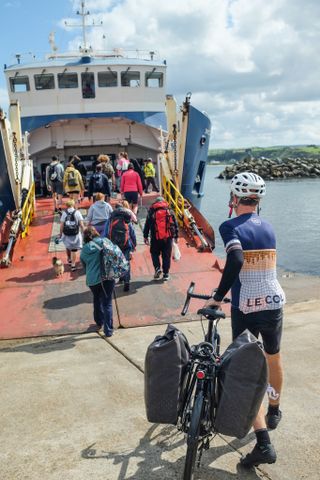
(Image credit: Anton Thompson-McCormick)
How to get there: We flew with EasyJet from London Gatwick to Belfast International, which costs £40-90 return.
Where to stay: On our first night we enjoyed a stunning sea view at the Ballygally Hotel (from £139/night). After a Torr-tuous day two, we were sumptuously refuelled at the Salthouse Hotel, Ballycastle (from £150/ night). Our final night was amid the friendly spirits of the Bushmills Inn (from £120/night).
Bike rental: Our bikes were kindly provided by cycle tours specialist Iron Donkey, whose seven-night, self-guided Causeway Coast tour costs £795 (plus £175 for road bike rental): irondonkey.com
Further reading: Many of Dervla Murphy’s groundbreaking travel books, including A Place Apart, are still in print, published by Eland: travelbooks.co.uk
Special thanks to Claire McCune and Tourism Ireland for their help in arranging our trip.
